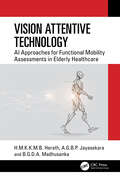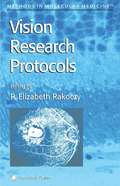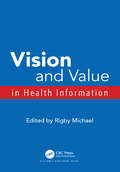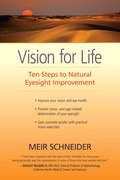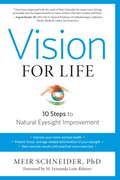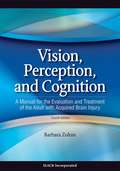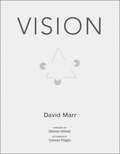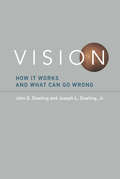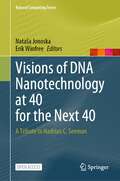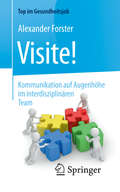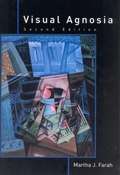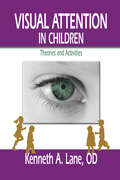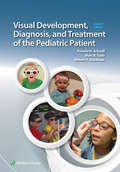- Table View
- List View
Visceral Pain: From Bench to Bedside
by Hong Jiang Ming Xia Bifa FanPatients with chronic visceral pain present a challenge for medical providers because of their vague presenting symptoms and frequent lack of identifiable pathology. Despite this, chronic visceral pain can be a debilitating medical condition that increases morbidity and decreases quality of life; the long-term consequences of which cause significant socioeconomic burden and debility. Covering the newest trends, studies, diagnosis and treatments in visceral pain care, as well as the pain treatment strategies that have been successfully employed in the past, this book brings readers fully up to date with effective recognitions and treatments for visceral pain. The clinical evaluation and presentation of common chronic visceral pain conditions and multimodal treatment options that can be used to assist patients and providers are focused.
Vision And The Brain: Understanding Cerebral Visual Impairment In Children
by Amanda Hall Lueck Gordon DuttonCerebral visual impairment (also known as cortical visual impairment, or CVI) has become the most common cause of visual impairment in children in the United States and the developed world. Vision and the Brain is a unique and comprehensive sourcebook geared especially to professionals in the field of visual impairment, educators, and families who need to know more about the causes and types of CVI and the best practices for working with affected children. Expert contributors from many countries represent education, occupational therapy, orientation and mobility, ophthalmology, optometry, neuropsychology, psychology, and vision science, and include parents of children with CVI. The book provides an in-depth guide to current knowledge about brain-related vision loss in an accessible form to enable readers to recognize, understand, and assess the behavioral manifestations of damage to the visual brain and develop effective interventions based on identification of the spectrum of individual needs. Chapters are designed to help those working with children with CVI ascertain the nature and degree of visual impairment in each child, so that they can "see" and appreciate the world through the child's eyes and ensure that every child is served appropriately.
Vision Attentive Technology: AI Approaches for Functional Mobility Assessments in Elderly Healthcare
by B.G.D.A. Madhusanka H.M.K.K.M.B. Herath A.G.B.P. JayasekaraThis book provides a comprehensive overview of the use of vision attentive technology and artificial intelligence methodologies for functional mobility assessment in elderly populations.Vision Attentive Technology and Functional Mobility Assessment in Elderly Healthcare, begins with a general introduction to vision-attentive technology and its uses in the care of older people. Next it examines functional mobility in senior populations and offers a critique of the methods used today for evaluation. The authors then present several artificial intelligence approaches and vision-aware systems used for screening age related diseases such as Parkinson's disease and sarcopenia. The book also presents the difficulties and possibilities of using visual attentive technology to identify functional impairments caused by aging.This book would be helpful to researchers in the field of healthcare, especially those interested in using technology to enhance patient outcomes. Geriatricians, physical therapists, and occupational therapists who treat older patients will also benefit from reading this book. It will also be helpful to readers who are studying biomedical engineering, artificial intelligence, and healthcare.
Vision Facts: Questions about the Human Eye
by Jason Yang Pidgeon CharlesVision Facts is a question and answer guide to the wonders of the human eye, its complex structures and the process of visual perception. It traces the journey of vision from a ray of light entering the eye to the processing done by the brain, to the development and aging of the human visual system and common disorders associated with both processes. Organized in an intuitive question-and-answer format and accompanied by clear diagrams, Vision Facts provides answers regarding your vision in a manner accessible to all who are interested. Each topic includes references to external resources such as lecture notes and research papers for those who wish to delve deeper. It is a perfect handbook for anyone who is interested in visual science, sensory processing, neuroscience, or physiology; and is an excellent reference for anyone considering a career in ophthalmology or optometry.°Some examples of the questions include the following. What is the resolution of the eye? Why do astronomers often cover flashlights with a red filter while stargazing? What is color-blindness and how does it occur? What role does vision play in the circadian rhythm? What chemical signals cause the eye to develop into its mature form? How does alcohol during pregnancy affect eye development? How well can a newborn baby see? How does being born prematurely affect vision? What is 20/20 vision? How does aging affect vision? These are all questions that are addressed in Vision Facts, along with countless more.
Vision For Life: Ten Steps To Natural Eyesight Improvement
by Meir SchneiderIn Vision for Life, natural health pioneer Meir Schneider shares ten essential principles of healthy vision discovered in his forty-year personal and professional journey. Born almost blind, Schneider taught himself to see and developed an innovative program of healing and recovery that has helped thousands of people regain and improve their health. Vision for Life is packed with exercises for a natural eye health routine, which you can immediately incorporate into your life, and includes a set of eye chart posters to use together with the book. This program is not only strengthening but also restorative and deeply relaxing. You will learn how to reverse developing issues before they cause damage and how to remedy existing problems including near- and far-sightedness and lazy eye as well as cataracts, glaucoma, optic neuritis, detached retinas and tears, macular degeneration, and retinitis pigmentosa. Vision for Life is not only for people who see poorly and would like to improve their vision, but also for those with 20/20 vision who wish to maintain their perfect eyesight as they grow older. Clients of the Meir Schneider Self-Healing Method experience their own capacity to bring about recovery, reversing the progress of a wide range of degenerative conditions such as arthritis and muscular dystrophy as well as eye disease. Based in part on the established Bates Method of eyesight improvement and in part on his own professional and personal discoveries, Meir Schneider's pioneering approach has helped thousands of people successfully treat a host of eye problems, including nearsightedness, farsightedness, astigmatism, lazy eye, double vision, glaucoma, cataracts, macular degeneration, retinal detachment, retinitis pigmentosa, and nystagmus. Born blind to deaf parents, Schneider underwent a series of painful operations as a young child and was left with ninety-nine percent scar tissue on his eyes, resulting in his being declared incurably blind. At the age of seventeen, he discovered how to improve his vision from one percent to fifty-five percent of normal vision with the eye exercises presented in this book. Today Schneider drives a car, reads, and proves time and again that vision can and does improve with exercise. His contributions to the field of self-healing are recognized by alternative health practitioners and medical doctors alike.
Vision Loss in an Aging Society: A Multidisciplinary Perspective
by John E. Crews Frank J. WhittingtonThis book makes an important contribution to our understanding of the many facets of experience facing those with eye problems. It does so through a multidisciplinary examination of the elements of professional practice, research, policy, and intervention related to vision loss and vision rehabilitation.
Vision Rehabilitation: Multidisciplinary Care of the Patient Following Brain Injury
by Penelope S. Suter Lisa H. HarveyProviding all of the necessary information required to provide post-acute vision rehabilitative care following brain injury, this multidisciplinary book bridges the gap between theory and practice and presents clinical information and scientific literature supporting the diagnostic and therapeutic strategies applied. It covers all areas of vision care including the structure and function of the eye, organization of visual perception in the brain, and rehabilitation concepts applied to the visual system. It offers cutting-edge research, prescribing lenses and prisms, and therapy techniques that will enable even the experienced clinician to provide enhanced care to the brain injury patient.
Vision Research Protocols
by P. Elizabeth RakoczyElizabeth Rakcozy and a team of leading clinical and experimental scientists describe in step-by-step detail the key techniques essential to effective molecular biological research in ophthalmology and optometry. These readily reproducible methods are adapted to the special requirements of vision research, with coverage that ranges from the most basic to the most sophisticated technologies. Included are methods for the down-regulation of gene expression, new gene therapy techniques, and for the development of transgenic and knockout animal models for testing novel therapies. Eminently accessible and clinically relevant, Vision Research Protocols provides experimental and biomedical investigators in ophthalmology and optometry with a rich panoply of most powerful tools with which to ask--and answer--all the important questions emerging from the dramatically advancing work in vision research today.
Vision and Aging: Crossroads for Service Delivery
by Alberta L. OrrVision and Aging: Crossroads for Service Delivery focuses on the impact of visual impairment on older persons and their families. It also discusses the extent of that impact when services in the aging and blindness fields theoretically designed to enable older visually impaired persons to function independently are not available or accessible.
Vision and Value in Health Information
by Rigby MichaelVision and Value in Health Information offers a significant challenge: to find a place for health information in the modernization of health services in the UK. It comprises a collection of key essays from eminent contributors on the innovative use and development of information in health care.
Vision and the Brain
by Amanda Hall Lueck Editors Gordon N. DuttonCerebral visual impairment (also known as cortical visual impairment, or CVI) has become the most common cause of visual impairment in children in the United States and the developed world. Vision and the Brain is a unique and comprehensive sourcebook geared especially to professionals in the field of visual impairment, educators, and families who need to know more about the causes and types of CVI and the best practices for working with affected children. Expert contributors from many countries represent education, occupational therapy, orientation and mobility, ophthalmology, optometry, neuropsychology, psychology, and vision science, and include parents of children with CVI. The book provides an in-depth guide to current knowledge about brain-related vision loss in an accessible form to enable readers to recognize, understand, and assess the behavioral manifestations of damage to the visual brain and develop effective interventions based on identification of the spectrum of individual needs. Chapters are designed to help those working with children with CVI ascertain the nature and degree of visual impairment in each child, so that they can "see" and appreciate the world through the child's eyes and ensure that every child is served appropriately.
Vision for Life
by Meir SchneiderIn Vision for Life, natural health pioneer Meir Schneider shares ten essential principles of healthy vision discovered in his forty-year personal and professional journey. Born blind, Schneider taught himself to see and developed an innovative program of healing and recovery that has helped thousands of people regain and improve their health. The exercises in this book will help you to create a basic eye health routine that you can immediately incorporate into your life. This program is not only strengthening but also restorative and deeply relaxing. You will learn how to reverse developing issues before they cause damage and how to remedy existing problems including near- and far-sightedness and lazy eye as well as cataracts, glaucoma, optic neuritis, detached retinas and tears, macular degeneration, and retinitis pigmentosa. Vision for Life is not only for people who see poorly and would like to improve their vision, but also for those with 20/20 vision who wish to maintain their perfect eyesight as they grow older.Clients of the Meir Schneider Self-Healing Method experience their own capacity to bring about recovery, reversing the progress of a wide range of degenerative conditions such as arthritis and muscular dystrophy as well as eye disease. Based in part on the established Bates Method of eyesight improvement and in part on his own professional and personal discoveries, Meir Schneider's pioneering approach has helped thousands of people successfully treat a host of eye problems, including nearsightedness, farsightedness, astigmatism, lazy eye, double vision, glaucoma, cataracts, macular degeneration, retinal detachment, retinitis pigmentosa, and nystagmus.Born blind to deaf parents, Schneider underwent a series of painful operations as a young child and was left with ninety-nine percent scar tissue on his eyes, resulting in his being declared incurably blind. At the age of seventeen, he discovered how to improve his vision from one percent to fifty-five percent of normal vision with the eye exercises presented in this book. Today Schneider drives a car, reads, and proves time and again that vision can and does improve with exercise. His contributions to the field of self-healing are recognized by alternative health practitioners and medical doctors alike.From the Trade Paperback edition.
Vision for Life, Revised Edition: Ten Steps to Natural Eyesight Improvement
by Meir Schneider M. Fernanda RibeiroAll parts of the body need exercise for optimal health, and the eyes are no different. Vision for Life presents an approach to eye health for people with 20/20 vision who wish to maintain their perfect vision as well as people who see poorly and would like to improve their eyesight. Clients of the Meir Schneider Self-Healing Method experience their own capacity to bring about recovery, reversing the progress of a wide range of degenerative conditions including eye disease. Based in part on the established Bates Method of eyesight improvement and in part on his own professional and personal discoveries, Meir Schneider's pioneering approach has helped thousands of people successfully treat a host of eye problems, including near- and farsightedness, astigmatism, lazy eye, double vision, glaucoma, cataracts, macular degeneration, retinal detachment, retinitis pigmentosa, and nystagmus. This revised edition includes a new chapter on children's eye health and new research and exercises for specific conditions, i.e., glaucoma and nystagmus, near- and farsightedness. Born blind to deaf parents, Schneider underwent a series of painful operations as a young child and was left with 99 percent scar tissue on the lenses of his eyes, resulting in his being declared incurably blind. At the age of seventeen, he discovered how to improve his vision from less than 1 percent to 55 percent of normal vision with the eye exercises presented in this book. Today Schneider drives a car, reads, and enjoys the benefits of full natural vision. He and his clients prove time and time again how much vision can improve with exercise. His contributions to the field of self-healing are recognized by alternative health practitioners and medical doctors alike. In Vision for Life, Schneider shares forty years of discoveries made on his personal and professional journey. The book details simple but effective techniques to gain great vision such as sunning and palming. Such exercises are not only strengthening but also restorative and deeply relaxing. The reader learns how to reverse developing issues before they cause damage or to remedy existing problems, including pathologies such as glaucoma, cataracts, macular degeneration, retinal detachment, and optic nerve neuropathy.From the Trade Paperback edition.
Vision, Perception, and Cognition: A Manual for the Evaluation and Treatment of the Adult with Acquired Brain Injury
by Barbara ZoltanVision Perception and Cognition, Fourth Edition is a concisely structured text that expertly addresses clinical reasoning and decision making for the entire evaluation and treatment process of the adult with acquired brain injury. Provided are theoretical information, guidelines for both static and dynamic assessment, information on specific standardized evaluations, guidelines for adaptive and restorative treatment based on described theoretical and evidence-based information, and information on environmental impact of client performance.
Vision: A Computational Investigation into the Human Representation and Processing of Visual Information
by David Marr Tomaso Poggio Shimon UllmanDavid Marr's posthumously published Vision (1982) influenced a generation of brain and cognitive scientists, inspiring many to enter the field. In Vision, Marr describes a general framework for understanding visual perception and touches on broader questions about how the brain and its functions can be studied and understood. Researchers from a range of brain and cognitive sciences have long valued Marr's creativity, intellectual power, and ability to integrate insights and data from neuroscience, psychology, and computation. This MIT Press edition makes Marr's influential work available to a new generation of students and scientists. In Marr's framework, the process of vision constructs a set of representations, starting from a description of the input image and culminating with a description of three-dimensional objects in the surrounding environment. A central theme, and one that has had far-reaching influence in both neuroscience and cognitive science, is the notion of different levels of analysis -- in Marr's framework, the computational level, the algorithmic level, and the hardware implementation level. Now, thirty years later, the main problems that occupied Marr remain fundamental open problems in the study of perception. Vision provides inspiration for the continuing efforts to integrate knowledge from cognition and computation to understand vision and the brain.
Vision: A Computational Investigation into the Human Representation and Processing of Visual Information
by David MarrAvailable again, an influential book that offers a framework for understanding visual perception and considers fundamental questions about the brain and its functions. David Marr's posthumously published Vision (1982) influenced a generation of brain and cognitive scientists, inspiring many to enter the field. In Vision, Marr describes a general framework for understanding visual perception and touches on broader questions about how the brain and its functions can be studied and understood. Researchers from a range of brain and cognitive sciences have long valued Marr's creativity, intellectual power, and ability to integrate insights and data from neuroscience, psychology, and computation. This MIT Press edition makes Marr's influential work available to a new generation of students and scientists. In Marr's framework, the process of vision constructs a set of representations, starting from a description of the input image and culminating with a description of three-dimensional objects in the surrounding environment. A central theme, and one that has had far-reaching influence in both neuroscience and cognitive science, is the notion of different levels of analysis—in Marr's framework, the computational level, the algorithmic level, and the hardware implementation level. Now, thirty years later, the main problems that occupied Marr remain fundamental open problems in the study of perception. Vision provides inspiration for the continuing efforts to integrate knowledge from cognition and computation to understand vision and the brain.
Vision: How It Works and What Can Go Wrong
by John E. Dowling Joseph L. DowlingOver the past fifty years, enormous progress has been made in understanding visual mechanisms and treating eye disorders. And yet the scientist is not always aware of the latest clinical advances and the clinician is often not up to date on the basic scientific discoveries. Writing in nontechnical language, John and Joseph Dowling, a neuroscientist and an ophthalmologist, examine vision from both perspectives, providing concise descriptions of basic visual mechanisms and related clinical abnormalities. Thus, an account of the photoreceptors is followed by a consideration of retinitis pigmentosa and macular degeneration; an explanation of the retina's function is followed by details of glaucoma and diabetic retinopathy. The authors begin with the cornea and lens, which project an image on the light-sensitive elements inside the eye, the photoreceptors, and how that process can be compromised by such disorders as cataracts and corneal disease. They go on to describe, among other things, how the photoreceptors capture light; retinal and visual cortical anatomy and physiology; and higher level visual processing that leads to perception. Cortical disorders such as amblyopia are discussed as well as specific deficits such as the inability to recognize faces, colors, or moving objects. Finally, they survey the evolution of our knowledge of vision, and speculate about future advances.
Vision: How It Works and What Can Go Wrong
by John E. Dowling Joseph L. DowlingDescriptions of basic visual mechanisms and related clinical abnormalities, by a neuroscientist and an ophthalmologist.Over the past fifty years, enormous progress has been made in understanding visual mechanisms and treating eye disorders. And yet the scientist is not always aware of the latest clinical advances and the clinician is often not up to date on the basic scientific discoveries. Writing in nontechnical language, John and Joseph Dowling, a neuroscientist and an ophthalmologist, examine vision from both perspectives, providing concise descriptions of basic visual mechanisms and related clinical abnormalities. Thus, an account of the photoreceptors is followed by a consideration of retinitis pigmentosa and macular degeneration; an explanation of the retina's function is followed by details of glaucoma and diabetic retinopathy.The authors begin with the cornea and lens, which project an image on the light-sensitive elements inside the eye, the photoreceptors, and how that process can be compromised by such disorders as cataracts and corneal disease. They go on to describe, among other things, how the photoreceptors capture light; retinal and visual cortical anatomy and physiology; and higher level visual processing that leads to perception. Cortical disorders such as amblyopia are discussed as well as specific deficits such as the inability to recognize faces, colors, or moving objects. Finally, they survey the evolution of our knowledge of vision, and speculate about future advances.
Visions of DNA Nanotechnology at 40 for the Next 40: A Tribute to Nadrian C. Seeman (Natural Computing Series)
by Nataša Jonoska Erik WinfreeThis open access book provides a unique and state-of-the-art view on DNA nanotechnology with an eye toward future developments. Intended as a tribute to Nadrian C. Seeman, who founded the field of DNA nanotechnology, the content is an exciting mixture of technical and non-technical material, reviews, tutorials, perspectives, new findings, and open questions. The book aims to inspire current researchers to sit back and think about the big picture, while also enticing new researchers to enter the field. Most of all, the book captures voices from a unique moment in time: 40 years after the publication of the first paper that envisioned DNA nanotechnology.From this vantage point, what are the untold stories, the unspoken concerns, the underlying fundamental issues, the overlooked opportunities, and the unifying grand challenges? What will help us see more clearly, see more creatively, or see farther? What is transpiring right now that could pave the way for the future? To address these questions, leading researchers have contributed 22 chapters, grouped into five sections: perspectives, chemistry and physics, structures, biochemical circuits, and spatial systems.This book will be an important reference point in the field of DNA nanotechnology, both for established researchers looking to take stock of the field and its future, and for newcomers such as graduate students and researchers in other fields who are beginning to appreciate the power and applicability of its methods.
Visite! - Kommunikation auf Augenhöhe im interdisziplinären Team
by Alexander ForsterGeballte Fachkompetenz!Dieses Buch zeigt Pflegenden, Ärzten und weiteren Mitgliedern der Gesundheitsfachberufe, wie man eine Visite effizient und erfolgreich im Team durchführen kann. Dabei ist eine sinnvolle Rollenverteilung genauso wichtig, wie die örtlichen Rahmenbedingungen und zeitlichen Absprachen.
Visual Agnosia (Second Edition)
by Martha J. FarahThe second edition of the classic book on visualagnosia, updated to include disorders of semantic knowledge andtopographic recognition, and integrating perspectives from functional neuroimaging throughout.
Visual Attention in Children: Theories and Activities
by Kenneth LaneIn typical child development, attention controls many aspects of learning, including memory, motor control, and problem solving. Attention organizes the constant influx of information that needs to be absorbed by children. Inside Visual Attention in Children: Theories and Activities, Dr. Kenneth A. Lane describes the positive aspects of attention that are needed for children to be successful in the classroom, such as concentration and vigilance, as opposed to negative aspects that can lead to failure, such as distractibility and confusion. This book is divided into two parts. The first eight chapters of the book explain attention and its relationship to vision and visual stimuli. The core topics discussed here include Autism, ADHD, Dyslexia, Executive Function, and Memory. The second half outlines a Vision Therapy program and consists of activities for improving visual attention in children. Over 100 activities are explained and illustrated.Visual Attention in Children: Theories and Activities is anchored on current theories in five areas of attention that shape child development.Theories Described Include:• Focused Attention – The ability to respond discreetly to visual, auditory, and tactile stimuli• Selective Attention – The ability to maintain behavioral or cognitive abilities in the face of distracting or competing stimuli• Shifting Attention – The ability to rapidly shift attention from one object to another• Sustained Attention – The ability to maintain a consistent behavioral response during a continuous or repetitive activity• Divided Attention –The ability to engage in more than one attention-focused task at one time.Visual Attention in Children: Theories and Activities is the perfect tool for occupational therapy students and clinicians as well as other professionals specializing in child development and learning who are looking to enhance their understanding of this topic and who need unique ideas and activities to add to their visual therapy training programs.
Visual Culture and Pandemic Disease Since 1750: Capturing Contagion (Science and the Arts since 1750)
by Marsha Morton Ann-Marie AkehurstThrough case studies, this book investigates the pictorial imaging of epidemics globally, especially from the late eighteenth century through the 1920s when, amidst expanding Western industrialism, colonialism, and scientific research, the world endured a succession of pandemics in tandem with the rise of popular visual culture and new media. Images discussed range from the depiction of people and places to the invisible realms of pathogens and emotions, while topics include the messaging of disease prevention and containment in public health initiatives, the motivations of governments to ensure control, the criticism of authority in graphic satire, and the private experience of illness in the domestic realm. Essays explore biomedical conditions as well as the recurrent constructed social narratives of bias, blame, and othering regarding race, gender, and class that are frequently highlighted in visual representations. This volume offers a pictured genealogy of pandemic experience that has continuing resonance. The book will be of interest to scholars working in art history, visual studies, history of medicine, and medical humanities.
Visual Development
by Nigel W. DawThe only book on the market to cover the psychophysics, anatomy, physiology, and clinical deficits of the developing visual system in an accessible format and length. The visual system is the most commonly studied aspect of the nervous system and is the primary model for the study of both normal development and the effects of environment and sensory deprivation on development. This third edition highlights new research and features a large number of illustrations, many in color. It can be used as a supplementary text in neuroscience and ophthalmology courses. This book is a great resource for both novice and advanced researchers in the field of vision.
Visual Development, Diagnosis, and Treatment of the Pediatric Patient
by Pam Schnell Marc B. Taub Robert H. DuckmanThis second comprehensive edition of Visual Development, Diagnosis, and Treatment of the Pediatric Patient combines basic concepts of vision development with clinical diagnosis and treatment of vision disorders in infants, toddlers, children, and adolescents. Heavily updated, with new sections on timely issues and topics, the book is ideal for anyone who needs to know the practical aspects of evaluation and care of pediatric patients.


